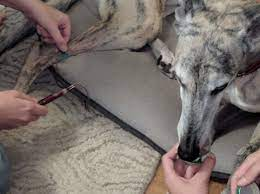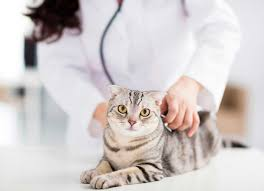Not all dogs and cats are the same. Some patients are comfortable and happy inside and outside their home and on visits to new places including the veterinarian. Other pets are fearful. This article will focus on veterinary visits for the fearful pet and how to ensure the visits become less stressful each time.

Dogs and cats are a little different in how they interact and socialize. Dogs are more pack oriented and unlike indoor cats, often are walked and may go to daycare or dog parks and more frequently travel with owners to new places.
Dogs

For fearful dogs at the veterinarian, it is important that your veterinarian and staff make your canine friend more comfortable each time. This should start with friendly greetings in the lobby and treats to help relax your friend.
In the exam room, we don’t want your dog with his/her tail tucked between legs and hiding in a corner. We want to go slowly and offer treats and praise until your pet gets comfortable moving around the examination room. This may take one visit or we can work with your pet weekly until they get comfortable walking on to the table and having their body pet and ultimately pinched lightly to mimic getting vaccinations. A lot depends on the level of anxiety your pet shows.
Your veterinarian should always do things in front of you, assuming your presence relaxes your pet, as long as it’s not involving radiation, surgery or a procedure that human precautions need to be taken.

Restraint should be gentle and as minimal as can be allowed to keep your dog safely on the table and (in case of fear-related aggression) the veterinarian and staff safe too. Many dogs are food motivated, so distraction with high value treats can often help warm up a frightened dog.
Again, this may take more than a single visit but your veterinarian and staff should go slowly until your canine companion is as comfortable as possible. Talk with your veterinarian about coming in for just friendly visits and also working with the practice’s staff to get your dog more comfortable in general.
Cats

By nature, cats are less pack oriented than dogs and if indoors, often have less familiarity with car rides and traveling places. You can help reduce cat anxiety by spraying a towel in the carrier with the pheromone called Feliway. This mimics the lactating mother cat’s pheromone and produces a calming effect.
Keep the carrier open and let your cat wander in or place him or her into it with the door open and pet them. start with 15-30 second periods and gradually increase. The next step is car rides. You can also spray Feliway into your car and place your cat in the carrier in the car.
At first just get your cat comfortable being in the car for a few minutes. high value treats for cats can be found in the squeeze food Churros. You may offer this while petting your cat in the car in his/her carrier.
Once your feline friend is more at ease go for short car rides. If vomiting occurs, ask your veterinarian if they can get you a medication for motion sickness. Like people, some cats do not travel well.
Check ahead of time if your veterinarian offers fear-free practices. this should include separate cat and dog exam rooms, Feliway in the cat rooms and staff comfortable with handling feline patients. Not all cats not to be handled the same way. Just like dogs, less can be more.
Some fearful cats do well with a towel placed over their heads. other may need gentle restraint. All should at least be offered treats during the visit, though some cats are more reluctant than dogs to take treats.
At Urban Animal, we have found about 75% of cats respond well to treats during visits and even some that are aggressive forget about aggression when properly distracted with treats.

If you feel that your cat isn’t being handled the way you would like, talk to your veterinarian and work with them to create a plan that best suits the needs of your cat. no two pets are the same and customized care is needed for the fear-stricken or shy animal.


